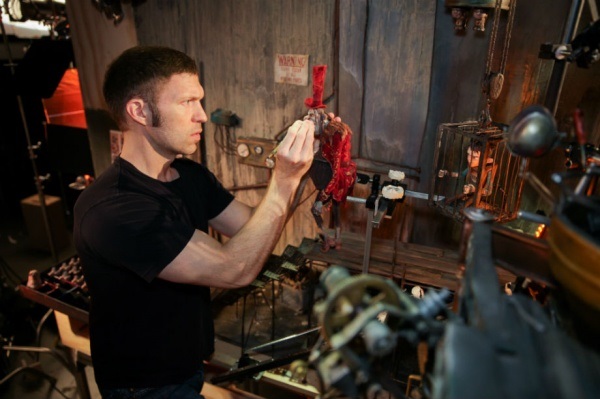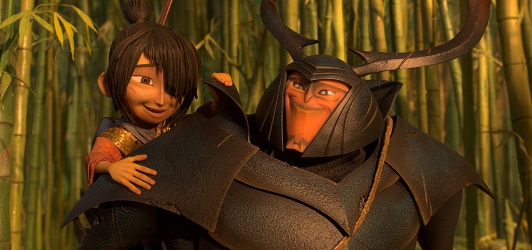By Gill Pringle
In the world of big screen animation, Travis Knight is anything but typical. He is the current president and CEO of against-the-grain animation house, Laika, but is also a key in-house creative. As well as heading up the boardroom, Knight also served as the lead animator on the company’s breakthrough 2009 hit, Coraline, and then took on both animating and producing duties on their successful follow-ups, ParaNorman and The Boxtrolls. His backstory is even more unconventional, with Knight once trading as a rapper under the moniker of Chilly Tee. He released an album in 1993 called Get Off Mine, which boasted production by The Bomb Squad – the pioneering soundscapers behind rap titans, Public Enemy – but failed to make a connection with audiences. “Nobody bought that record,” Knight told The Portland Monthly. “I liked making music, but I hated the performing part of it. There’s a reason why most animators are hidden behind giant curtains: they’re not meant for the spotlight.” As an animator, Knight joined Will Vinton Studios, first as an intern, and then worked as a stop-motion animator, working on the television series The PJs, (produced with Eddie Murphy Productions), as well as the animated series, Gary & Mike. Knight animated numerous television commercials and promo spots, before beginning what would turn out to be his hugely successful tenure with Laika. Knight, however, was no stranger to success: his father, Phil Knight, is the founder and chairman of Nike, Inc, one of the biggest sporting wear companies in history.
But now, along with serving on the board of directors of his father’s company, and his various commitments at Laika, Travis Knight has made his directorial debut with Kubo And The Two Strings, a vivid, stunningly realised stop-motion action fantasy. Set in a fantastical version of ancient Japan, the film follows the clever, kind hearted youngster, Kubo (voiced by Art Parkinson of Game Of Thrones), who must set out on a thrilling quest to save his family and solve the mystery of his fallen father. Kubo finds two unlikely friends and mentors in Monkey (Charlize Theron) and Beetle (Matthew McConaughey), who help him to unlock the secret of his legacy, reunite his family, and fulfil his heroic destiny. Already receiving raves, FilmInk spoke one-on-one with Travis Knight at a special press event during the film’s lengthy post-production process.

Why this movie for your directorial debut? Was it the story that got you? “It’s been around for ten years now, and as part of the core of our mission, we always strive to tell new and original stories. We want to do things that are thematically rich, and emotionally resonant. We want our films to be challenging in some way, and to tell beautiful stories. Every single time out, we try to do something new. We don’t want to keep repeating ourselves. At the studio, there is a philosophy that there is an inherent restlessness in what we do, and that we’re always trying to do something new and interesting and exciting. We want to push the medium beyond where it’s been before. We’ve been developing Kubo And The Two Strings for half a decade. It’s an original idea that started here at the studio. We were working on ParaNorman at the time, and I remember thinking that I wanted to take stop motion beyond where it’s been before. There are certain things that stop motion does very well, and there are other things that it struggles with. And part of that is spectacle: big, epic, cinematic spectacle, and big action set pieces. On a simple, mechanical level, I wanted us to tell that kind of story…a big Star Wars-style epic fantasy. I wanted us to do something that had sweep and scale.”
But it’s more than that… “With everything that we do at Laika, there is always a critical element of something that is personal underneath – a deep, strong beating heart that animates everything, and with this story, we have that in spades. It really is a very intimate story about human connection and relationships on this big, epic scale. So it had all those sorts of ingredients that I thought were critical for a successful and enriching and engaging film. What’s more, just in terms of the aesthetics of it, there was the opportunity to explore this sweeping samurai story in our medium, which was something that we haven’t really seen before. As a kid, my dad was an entrepreneur, and on rare occasions, I would be able to tag along with him. I remember the first time that we went to Japan – this was over thirty years ago – being struck by how completely different it was to my life growing up in Oregon. I was struck by the spare poetry and the beauty of the artistry of the aesthetic. It was always something that resonated with me, even as a young child. It has been a huge part of my life. I loved [the film and television series] Lone Wolf & Cub, and I love [Akira] Kurosawa and [Hayao] Miyazaki, and this was an opportunity to tell a beautiful story that was epic in scale and personal in nature and that was also a reverent nod to the beautiful Japanese aesthetic and artistry.”

What was the original story? Who had the idea? Was it one of the writers at Laika? “Yeah, our character designer on the film came up with the original idea, and then we worked with a small team of us to develop the story. There was also Chris Butler, who was also the writer and director on ParaNorman, and our writers, Marc Haimes and Arianne Sutner. The four or five of us developed the story over the last five years.”
Was this family trip to Japan also the birth of your love of stop motion? “No, those things are separate. Although in terms of when they happened, it is fairly close at the same time. It was before I was even ten-years-old. I was pretty young. I’ve been to Japan many times since then. It was right around that time as a child when you have an awakening of curiosity, and you’re old enough to start to find those hidden connections between things, but not yet too old to have a jaded perspective. It’s that age when you’re open to new possibilities. So all of those things happened at the same time. I also had a deep and abiding love for [stop motion pioneer] Ray Harryhausen, and that started my merging love for Japanese culture, narrative, and art.”

Every time that the press has been to Laika, we’ve seen you on your own stage animating a scene. As a director now, are you still doing that? “I am. I’ve got two more shots left to do on the movie, and finding the time to do it is a challenge. But it’s always been an important part of what I do. I was drawn to the medium because of my love for the art. So I’ve been doing this professionally for nearly 20 years as an animator. Even once I started to do different things within the company, I didn’t want to lose that direct, hands-on connection with the art. It’s absolutely critical for what we are philosophically, which is a team of artists who bring things to life and are very passionate about what we do. You see that in virtually every role in the company. We don’t have bureaucracy here. So when I made the transition to directing the movie, I was thinking, ‘Can I animate and direct and run the company at the same time?’ Then I started thinking, ‘Well, Ben Affleck can act, and direct, and clearly I’m as good as Ben Affleck.’ [Laughs] It turns out that I’m not quite as good as Ben Affleck! While I have been doing some animation of the film, it’s not nearly as much as would be expected, and it’s not as much as I did on the other films.”
Which are your scenes? “It’s kind of all throughout the film. The one that I’m finishing up right now is the opening sequence of the film where Kubo’s mum is on the beach, crawling towards the baby. So, it’s a nightmare! Sand! And I’m dealing with little particles like I did with the zombie rise on ParaNorman…it all just takes time. I hate it. The process is painful, but I absolutely love what I do. When you can see something that is a physical object that is completely inert and has no life, and then you see it come on the screen and it comes to life and feels like it’s an emoting, living, breathing creature that has hopes and dreams and aspirations, and that has feeling and is living in the moment, it’s magic to me. Seeing this thing brought to life through an artist’s hands is just an extraordinary thing. It’s a wonderful thing for me to be a part of. So I will never stop doing it even if it’s not quite as much as I used to do.”
Kubo And The Two Strings is in cinemas from August 18. Click through for the second, third, and fourth parts of our exclusive, extended interview with Travis Knight.




